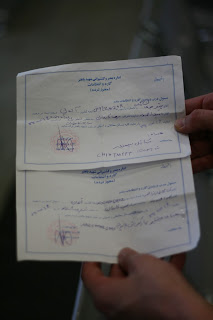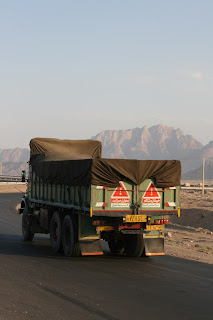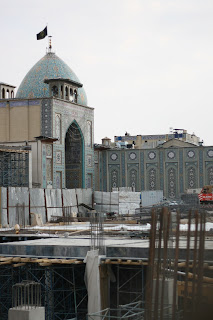So, Thursday before noon was the plan,
over 500km in 24h. Highways in Iran are not bad (the drivers are in
compensation), so we rushed through once again, making Iran a country
to outscore Turkey in terms of our km/day average.
In the humid, rather unspectacular port town Bandar Abbas, we made it just in time to the ticket agency. 80€ for 2 persons, and 440€ for the car is an expensive price for a 12h-boat ride. Monopoly gets paid.
 |
| We had a blind passenger in Kalimero. |
 |
| Not only Diesel, also Gas is a much-wanted good. |
In the humid, rather unspectacular port town Bandar Abbas, we made it just in time to the ticket agency. 80€ for 2 persons, and 440€ for the car is an expensive price for a 12h-boat ride. Monopoly gets paid.
In front
of the office, we had a joyful sighting: a German Unimog (named Simba) was waiting,
and we met the 2 overlanders from Munich, Peter and Jenifer inside
the A/C-cooled office while Kalimero and Simba exchanged their stories outside.
This meant, having to spend 60h (and hopefully
not more) in this hot climate NOT alone. The 2 arrived the day before
and slept on a parking ground on the coastal line.
We had Kalimero washed, some food
reserves stocked up and started looking for the overnight spot. Cruising up and
down the shore line (hmmm, we had seen more beautiful beaches), a guy
suddenly ran on our street line towards us. Nothing special in this
country, Michi reasoned and honked (adapted to Iranian driving
style). But this guy was different – European. It turned out that
Andy and Frank, the two DAF-drivers we travelled with in Turkey and
Armenia, were in town for a reasonable touristic reason: the India
visa takes 10 days here, and 21 in Tehran. Andy had seen Kalimero
when sitting on the beach smoking water pipe, chased to find a taxi
and had a wild pursuit (Kalimero is faaaast!), to finally catch us when we u-turned.
So, were 6 people in Bandar Abbas,
waiting for Iranian or Indian buerocracy to continue our travel
plans. Andy and Frank had found a sufficiently clean hotel with own
showers, WiFi and A/C-rooms for the bargain price of 10€ for 2
persons. At 40° and 90% humidity, it was not a hard decision what to
do.
 |
| Simba and Kalimero in downtown Bandar Abbas. |
 |
| Peter and Jen, the 2 Unimog drivers. |
 |
| Frank and Andi, the two DAF drivers. |
 |
| Our 5* Hotel. The gym, Jacuzi and Wellness area was just about to be constructed. |
After 2 chilling/chilled (literally,
with A/C set at 16°) nights, we then started at 7.30am to fight the
battle against buerocracy – willing to spend the day at the port
(our vessel was scheduled to depart at 10pm). It turned out we were
very lucky to be not alone, as Michi and Peter fought on the front,
while Katha and Jenifer suffered while guarding the cars.
The principle was simple: get your VIN
checked, compared to your papers, compared to your Carnet de Passage.
If correct, get a customs check, and park you car in front of the
ship, so that others can still pass. Then, wait for passport control,
get your emigration stamp, board the vessel with the car. But, Iranian buerocracy was more than this.
 |
| These 2 pieces of paper are necessary to go to the car and get a bottle of water and a book. Every line on the back took about 5 minutes of dicussions and phone calls. |
Unfortunately, we were not allowed to
film in the port. However, we found a movie that represents quite
well how this simple-seeming procedure takes place in an Iranian port, with Iranian customs:
(to those of you who don't understand
the language of what's happening: don't worry, neither did we)
It took us until 3pm until we seemed to
be successful in at least having tickets, our carnets stamped and
processed, and finding us in an A/C „departure hall“ with Simba
and Kalimero parked in front. We have to mention that we had the
extremly precious help of a local agent who does car import and
transit regularly and waited for his vessel/“his“ 5 cars to arrive. He knew
exactly where to go for which of the 723 stamps, whom to ask, where
to get photocopies etc etc.
Thank you, Omid, it would have took us until late evening at least without our help.
Thank you, Omid, it would have took us until late evening at least without our help.
Plus, we still don't know whether
you normally have to pay diesel tax when leaving Iran. We did not –
but we collected a fair number of stamps and signatures in the
official noon break, knocking on door, discussing (Omid) or smiling
and saying „Salam“ politely (Michi&Peter).
 |
| Many brand new cars were unloaded at the port. |
 |
| But, as we learned from Omid, were not allowed to be imported to Iran (due to the embargo). The cars were for transit to Azerbaijan or Iraq) and were immediatly loaded on car transporters. |
 |
| The main export goods in the port were fruits and vegetables, loaded on antique vessels to go to the UAE. |
Well, we considered 8am to 3pm was an
easy warmup in waiting, so we decided to do some Iranian math 4
hours later.
- The federal ferry company's web page (a masterpiece of HTML programming ) gives
out cryptic numbers that we interpreted as 10pm as ferry ETOT.
- Our tickets
said 9pm, and
- the customs officer told us we should start boarding at
6 or 7pm.
So, we picked 7pm as a good time to move to the next hall,
where our passports should get stamped. Turned out to be a difficult
task, considering that Michi currently has a beard while the person
on the photo of the passport he presented has none. After 2 perplex
minutes, the police officer then finally proceeded and gave him the
emigration stamp, accompanied with a gesture of
surprise/non-understanding/non-knowledge (we saw this one often
during our time in Bandar Abbas).
 |
| The iAtollahs overlooking all border crossings. |
Done with the stamping at 8pm, we then
were allowed to wait another hour before going out to the car.
Sitting in the car, the open ferry mouth in front of us, we were told
that the remaining 3 cars had to be unloaded before we can load ours.
This took another hour, during which about 15 cars departed from the
vessel. We drove Simba and Kalimero on board, just to find that the
imported cars were on the 2nd floor, with about 40 pieces left (which continued to be unloaded).
We sat at some wooden benches at the back of the ship, had dinner inside the A/Ced passenger compartment, and went back to the wooden benches to sleep (choose between 35° outside and 15° inside).
 | |
| Three Turkish trucks and some Iranian stone/marble plates were to be loaded in between Simba and Kalimero. |
We sat at some wooden benches at the back of the ship, had dinner inside the A/Ced passenger compartment, and went back to the wooden benches to sleep (choose between 35° outside and 15° inside).
It was until 1.30am that we should wait
for departure, finally heading to UAE. Soon, the first officer was
very kind to offer us the „VIP area“, a saloon with 20° A/C
where we were allowed to sleep on sofas. What a relief after this
long day! Generally, the staff on the ship was very funny and extremly helpful. This helped us to keep in mind how 98% of all Iranians are, at least when they do not have custom- or car export-associated tasks.
After very interesting invitations to
the main bridge (getting explained the radar and the steering
mechanisms – we don't have photos, we are not spies!), we finally pulled into
Sharjah harbour at 11am (at least somewhat relaxed).
In Sharjah, we were allowed to pay our
ferry fees (what a pleasure!) and do another customs marathon. This
time, it was less stressful, as UAE harbour workers (generally of
Indian subcontinental origin), policemen and custom officers
(generally Persians or Thai/Phillipinos/etc) or custom officials behind
thick glass panels (generally Arabian) all spoke and understood
English, and all procedures were normalized without having to know or bribe the right people.
Still, the procedure was very simple in principle:
get your arrival paper by your shipping
company (after paying – needless to say that the Federal Iranian
Ferry company does not want Iranian Rial, they want UAE dirhams. So go to the ATM first. Wait, it's behind a security line, so get a
police officer to accompany you)
apply for a security investigation (get
stamp)
pay for application (get signature
under stamp)
tell will to pay for investigation (get
piece of paper)
pay sum, calculated by dechiffring the
code on the little piece of paper (get payment certificate)
get stamp on your inital paper by showing payment certificate
give initial paper to officer, go to the car,
show him VIN
get stamp and your VIN written on your
intial paper
go back to Customs, present your carnet
and the inital (now with VIN) paper - wait 20min - get your carnet back
get another stamp from your shipping
company, that you have done customs
with this stamp, pay the port fees
(handling etc) and get your (final?) stamp
get a gate pass that you may finally
leave the port area, as you have paid your freight, paid the port
fees and done customs
Of course, this process could be very
efficient and done in 1 hour. Provided everybody is working, and you
do NOT have to change buildings for every single step. And these buildings are built close to each other, and not 1km apart.
But, neither was the case, so it was
4.30pm before Kalimero's wheels finally touched UAE territory behind
the last gate.














































